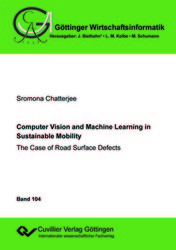| Departments | |
|---|---|
| Book Series (96) |
1378
|
| Nachhaltigkeit |
3
|
| Gesundheitswesen |
1
|
| Humanities |
2365
|
| Medienwissenschaften | 16 |
| Theology | 57 |
| Philosophy | 102 |
| Law | 422 |
| Economics | 850 |
| Social sciences | 416 |
| Sports science | 48 |
| Psychology | 233 |
| Educational science | 190 |
| History | 182 |
| Art | 111 |
| Cultural studies | 166 |
| Literary studies | 117 |
| Linguistics | 88 |
| Natural Sciences |
5406
|
| Engineering |
1793
|
| Common |
98
|
|
Leitlinien Unfallchirurgie
5. Auflage bestellen |
|
Advanced Search
Computer Vision and Machine Learning in Sustainable Mobility: The Case of Road Surface Defects (Volume 104) (English shop)
Sromona Chatterjee (Author)Preview
Extract, PDF (1.9 MB)
Table of Contents, PDF (650 KB)
Road maintenance has traditionally been a time consuming, expensive, and manual process. Timely maintenance of roads helps in lowering rehabilitation costs, accidents, environmental pollution, while facilitating increased connectivity, trade, and growth. Easily acquirable front-view scene images are seen to be used lately for infrastructure management and road maintenance as they provide quicker, low-cost, and flexible solutions. Such scene images can easily be acquired using standard commodity cameras. In this dissertation, machine learning based approaches have been developed to analyze front-view scene images for detecting cracks automatically on road surfaces across different locations and under various conditions. This work thus contributes toward automated approaches to detect different kinds of cracks on road surfaces, thereby proposing a low-cost solution to road maintenance practices. As a result, different components are developed in this work which are sketched together to form a Decision Support System for the task of crack detection. In this study primarily three algorithmic approaches have been developed. Firstly, an unsupervised graph-based hierarchical clustering technique for road area segmentation has been developed, thus helping in detecting the road area in scene images. Secondly, a classifier and superpixel based supervised learning approach consisting of systematically identifying relevant features for detecting superpixels containing cracks has been developed. Thirdly, an unsupervised learning approach consisting of Gamma Mixture Fuzzy Model based clustering technique and keypoint matching mechanisms have been designed in this work for detecting which road pixels are crack pixels in images. Finally, this study integrates the findings and approaches to propose a Decision Support System for crack detection on road surfaces of easily acquirable front-view scene images. Evaluations performed on an experimentally collected diverse front-view scene image dataset show promising results for crack detection using the developed approaches in this work.
| ISBN-13 (Hard Copy) | 9783736972582 |
| ISBN-13 (eBook) | 9783736962583 |
| Final Book Format | A5 |
| Language | English |
| Page Number | 198 |
| Lamination of Cover | glossy |
| Edition | 1 |
| Book Series | Göttinger Wirtschaftsinformatik |
| Volume | 104 |
| Publication Place | Göttingen |
| Place of Dissertation | Göttingen |
| Publication Date | 2020-08-18 |
| General Categorization | Dissertation |
| Departments |
Economics
Informatics |
| Keywords | Computer vision, image processing, machine learning, artificial intelligence, information systems, IS, decision support system, pavement management system, PMS, pavement condition index, PCI, road monitoring, road surface analysis, cracks, crack detection, surface defect detection, network cracks, single cracks, GPS, e-bike, pedelecs, road detection, Structured and unstructured, pavement detection, region grouping, pairwise assignment, Hungarian algorithm, hierarchical clustering, Superpixel, Random forest, Gradient boosting, Aritifical Neural Network, Support vector machine, Design Science Research, Gray level co-occurrence matrix, defect detection, Gamma mixture fuzzy model, Fuzzy image descriptors, edge detection, KL-divergence, Bildverarbeitung, Maschinelles Lernen, Künstliche Intelligenz, Informationssysteme, IS, Entscheidungsunterstützungssystem, digitale Innovation, Bürgersteig-Management, Bürgersteig-Verwaltungssystem, PMS, Belagszustand index, PCI, Straßenüberwachung, Analyse der Straßenoberfläche, Risse, Risserkennung, Erkennung von Oberflächenfehlern, Netzwerk-Risse, einzelne Risse, GPS, E-Bike, Pedelecs, Straßenerkennung, Strukturiert und unstrukturiert, Fahrbahnerkennung, Gruppierung von Regionen, paarweise Zuordnung, Ungarische Methode, hierarchische Clusteranalyse, Superpixel, Klassifikationsverfahren, Random Forest, Gradient Boosting, künstliche neuronale Netzwerke, Support Vector Machine, Design Science, Gray level co-occurrence matrix, Fuzzy-Bild-Deskriptoren, Fuzzy-Theorie, KL-Divergenz, Entscheidungshilfe, Aerial Vehicle, Luftfahrzeug |
Rezension
Road maintenance has taditionally been a time consuming, expensive, and manual process. Timely maintanance of roads helps in lowering rehabilitation costs, accidents, enviromental pollution, while facilating increased connectivity, tade, and growth. Easily acquirable frontview scene images are senn tob e used lately for infrastructure management and road maintenance as they provide quicker, low-cost, and flexible solutions. Such scene images can easily required using standard commodity cameras. In this dissertation, machin elaerning based approaches has been developed to analyse front-view scene for detecting cracks automatically on road surfaces across different locations and under various conditions. This word thus contributes toward automated approaches to detect different kinds of cracks on road surfaces, thereby proposing a low-cost solution to road maintenance pactices. As a result, different components are developed in this work which is sketched togehther to form a Decision Support System fort he task of crack detection. In this study primarily three algorithmic approaches have been developed. Firstly, an unsupervised graph-based hierarchical clustering technique for road area segementation has been developed, thus helping in detecting the road area in scene images. Secondly, a classifier and superpixel based supervised learning approach consisting of systematically identifying relevant features for detecting superpixels containing cracks has been developed. Thirdly, an unsupervised learnig approach consiting of Gamma Mixture Fuzzy Model based clustering technique and keypoint matching mechanisms hace been designed in this work for detecting whiach road pixels are crack pixels in images. Finally, the study integrates the findings and approaches to propose a Decision Support System for crack detection on road surfaces of easily acquirable front-view scene images. Evaluations performed on an experimentally collected diverse front-view scene image dataset show promising results for crack detection using the developed approaches in the work.
Sören Glaubitz, Fraunhofer IRB








